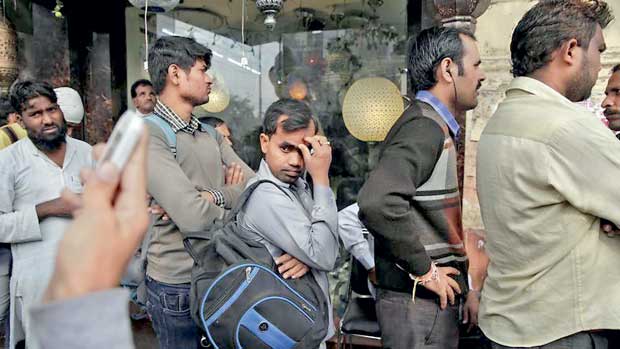07 Jun 2017 - {{hitsCtrl.values.hits}}

 Providing enough employment opportunities in India with a population of 1.34 billion is not easy. And the fact that half of the population is below the age of 25 and will soon enter the job market will only make matters worse.
Providing enough employment opportunities in India with a population of 1.34 billion is not easy. And the fact that half of the population is below the age of 25 and will soon enter the job market will only make matters worse.
In response, the government has come up with initiatives such as ‘Make in India’, ‘Skill India’ and ‘Start-up India’ to promote employment. But the 2015–16 Annual Employment and Unemployment Survey found that the labour force participation rate (LFPR) nationally was only 50.3 percent. And the LFPR is much lower for females than for males. The survey shows sluggish employment growth and the growth varied across sectors. While sectors such as IT have seen growth, other sectors such as jewellery, automobile manufacturing and transport have seen a decline in employment in recent years.
In India, agriculture accounts for 46 percent of the workforce, compared to 22 percent in manufacturing and 32 percent in services. Despite various policy initiatives, the manufacturing sector has not been able to create mass employment, unlike in countries such as China. Further, casual and contractual employment is replacing permanent jobs in the manufacturing sector.
In 2016, India’s unemployment rate was 7.97 percent, with rural unemployment at 7.15 percent and urban unemployment at 9.62 percent. In rural areas, unemployment figures are lower due to the ‘Mahatma Gandhi National Rural Employment Guarantee Act’ (MGNREGA). This act aims to guarantee the ‘right to work’ by providing at least 100 days of paid employment in a financial year to every household whose adult members volunteer to do unskilled manual work. In the Union Budget 2017–18, the MGNREGA received Rs.480 billion (US $ 7.5 billion). While the act has helped to lower the unemployment rates, it has not been able to tackle disguised unemployment/underemployment. And such programmes focus only on unskilled employment.
To connect job seekers to potential employers, the Labour and Employment Ministry launched the National Career Service portal. The portal is a common platform connecting job-seekers, employers, skill providers, placement organisations and counsellors. In the same month as the National Career Service was launched, Pradhan Mantri Kaushal Vikas Yojana — a skill development scheme — was launched by the Skill Development and Entrepreneurship Ministry to help young people learn industry-relevant skills and enable them to secure skilled employment.
While these schemes may increase employability through skill upgrading, one of India’s largest employers of educated youth — the IT sector — has begun laying off employees. Companies like Wipro, Cognizant and Infosys have announced that they will downsize. While there was 8.6 percent growth in the IT sector in the 2016–17 financial year, jobs only grew by 5 percent, compared with 6 percent in 2015–2016. This downward trend is predicted to continue, with a 20–25 percent reduction in growth in employment in the IT sector over the next three years.
Industry experts blame this on automation, artificial intelligence and stricter visa norms in key markets such as the United States, the United Kingdom and Australia. Some companies have announced that they will focus on new technologies such as artificial intelligence, rather than concentrating on low-skilled IT jobs.
But this technological advancement need not impact job creation — India can instead move towards a knowledge-based economy by focusing on high-value manufacturing and enrolment in quality higher education.
Disparity in access to higher education leads to unemployment among the youth. Countries such as South Korea have successfully developed the higher education sector through private participation, while the Singaporean government has launched a programme to establish partnerships between domestic and foreign universities to promote tertiary education. India could learn from these examples.
Moreover, India needs to change its anarchic labour laws which lead to creation of contractual jobs instead of permanent employment. Retail is a labour-intensive sector and foreign investment in retail would create jobs in the both retail and related sectors like apparel manufacturing and logistics. Similarly, allowing foreign investment in sectors like legal and accountancy services will create employment as more foreign firms move to India. Infrastructure investment can also be utilised as an engine of job creation.
Finally, India needs to sign trade agreements conceding to its partners’ requests to open sectors like insurance, legal services and retail and in return, bargain for easier work visa norms.
With these smarter policies, India can move towards permanent positions in high-value sectors and need not fear technological advancement or unemployment.
(Courtesy East Asia Forum)
(Arpita Mukherjee is Professor and Avantika Kapoor is a Research Assistant at the Indian Council for Research on International Economic Relations, New Delhi. The views expressed herein are the authors’ own)
07 Jan 2025 7 hours ago
07 Jan 2025 7 hours ago
07 Jan 2025 8 hours ago
07 Jan 2025 07 Jan 2025
07 Jan 2025 07 Jan 2025